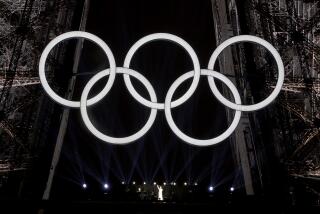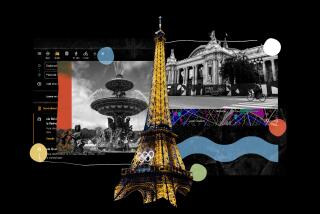Many Make Their Mark on Paris’ ‘Iron Lady’
- Share via
PARIS — One thousand feet up, near the Eiffel Tower’s wind-whipped summit, the world comes to scribble.
Japanese, Poles, Brazilians, Americans -- they graffiti their names, loves and politics on the cold iron, transforming the most French of monuments into a symbol of a world on the move.
“Little cat brought frightened little pig here on a visit,” says a Chinese inscription daubed in white correcting fluid in November.
Anna, presumably from Germany, marker-penned that she “was hier” in September.
“Ole! Ecuador,” scrawled an excited South American.
With Paris laid out in miniature below, it seems strange that visitors would rather waste time marking their presence than admiring the view. But the graffiti also raises a question: Why, nearly 114 years after it was completed, and decades after it ceased to be the world’s tallest structure, is la Tour Eiffel still so popular?
The reasons are as complex as the iron latticework that graces a structure some 90 stories high. But part of the answer is, no doubt, its agelessness. Regularly maintained, it should never rust away. Graffiti is regularly painted over, but the tower lives on.
“The tower will outlast all of us, and by a long way,” says Isabelle Esnous, whose company manages the landmark.
That might have seemed unlikely more than a century ago when Gustave Eiffel revealed his plan.
“The dishonor of Paris!” French luminaries thundered in a protest to the government on Feb. 14, 1887, just weeks after workers started digging the foundations for the 1,069-foot tower.
Novelist Joris-Karl Huysmans called it “a suppository riddled with holes.” For Leon Bloy, another writer, it was a “truly tragic street lamp.”
Time quickly proved the critics wrong. Nearly 2 million visitors went up the tower during the Paris World Fair of 1889, thrilling to the sensation of height in the pre-aviation age. The fair was an exposition that marked the centennial of the French Revolution with a show of technological might, dramatizing France’s emergence from the shame of military defeat by Germany 19 years earlier. The tower was its centerpiece.
Late this summer the 200-millionth visitor clicked through the turnstiles. The Empire State Building, taller than the Eiffel Tower, claims 110 million visitors since it opened in 1931.
Adults pay $9.90 for a ticket to the top. Profits -- nearly $6 million in 2001 -- go to the City of Paris, which owns the tower. The partly private, partly public company that operates and maintains it, Societe Nouvelle d’Exploitation de la Tour Eiffel, says the tower is the most-visited paying monument in the world.
“It’s a real money-spinner,” said Esnous, the company spokeswoman.
And fittingly for a structure that defies nature, it has only grown more popular with the age of mass tourism. It took 94 years to rack up 100 million visitors, but just 19 years to reach 200 million.
Gustave Eiffel expected about 500,000 visitors a year; this year, it drew more than 6 million.
One of them was Shao Yupei, 18, a student from Shanghai. “It’s like standing on the top of the world,” he said, gazing from the top deck that swayed slightly in the chill December wind.
“It represents Paris and Paris is France. It’s very symbolic,” says Hugues Richard, 31, a Frenchman who holds the record for cycling up to the tower’s second floor -- 747 steps in 19 minutes, four seconds, without touching the floor with his feet.
“It’s our iron lady; it inspires us,” he says.
But to what? After all, the tower doesn’t really have a purpose. It ceased to be the world’s tallest in 1930 when the Chrysler Building went up in New York. Yes, television and radio signals are beamed from the top, and Eiffel, a frenetic builder and tinkerer who died Dec. 27, 1923, at age 91, used its height for conducting research into weather, aerodynamics and radio communication.
But in essence the tower inspires by being there -- a blank canvas for visitors to make of it what they will. To the technically minded, it’s an engineering triumph. For lovers, it’s romantic.
Daredevils, stunt-artists and the plain foolhardy see a taunt: Come prove yourself on me.
A British couple parachuted 910 feet from the top deck in 1984. A New Zealander bungee-jumped off the second floor, 380 feet up, in 1987. In March, protesters climbed the pillars to hang banners objecting to China’s occupation of Tibet. In 1974, 13 young American streakers ran under it. Ten years later, Vietnam War veteran Robert Moriarty flew a single-engine plane through the bottom arches, “just for the fun.”
Hundreds have died at the tower. Most were suicides, but there was also Franz Reichel, an Austrian tailor who leaped 188 feet from the first deck in 1912 to test a tent-like parachute coat he had invented. He is said to have died of fright before hitting the ground, gouging a hole nearly a foot deep.
The first suicide was reportedly a printer’s mechanic who hanged himself from the north pillar in 1891, bequeathing his clothes to Eiffel. Esnous, the tower spokeswoman, said the last suicide was about two years ago, but it’s not a subject tower operators like to discuss.
“It gives people ideas,” she said. “There are attempts every now and then, but the staff are very vigilant.”
After taking two elevators to reach the top, some visitors set almost straight to work scribbling on the brown paint. Most just marvel.
“Oh, look at that ray of sunshine,” says Bernadette Bleriot, a Parisian in her 50s making her first ascent because her niece, up from the south, wanted to visit.
“Nobody wanted it at first,” Bleriot says of the tower. “But for me, Paris is la Tour Eiffel.”
More to Read
Sign up for The Wild
We’ll help you find the best places to hike, bike and run, as well as the perfect silent spots for meditation and yoga.
You may occasionally receive promotional content from the Los Angeles Times.






